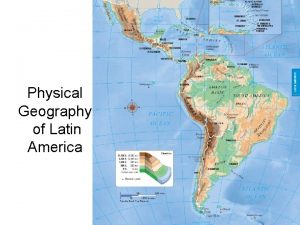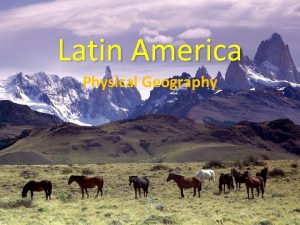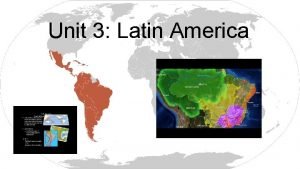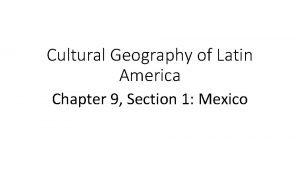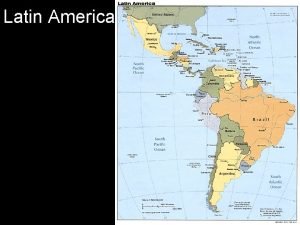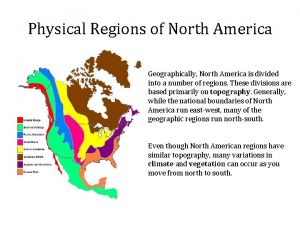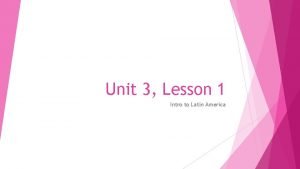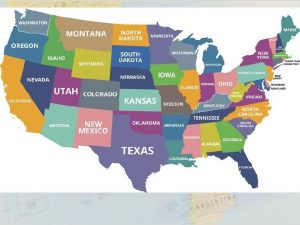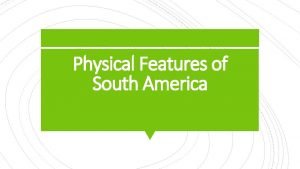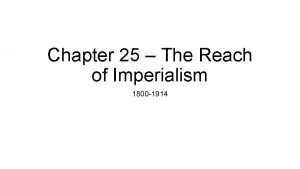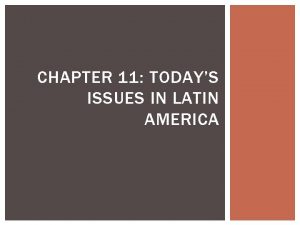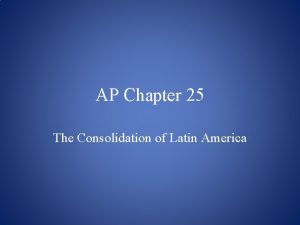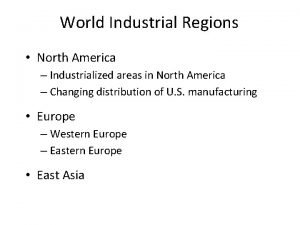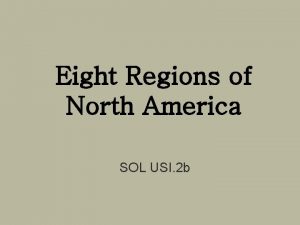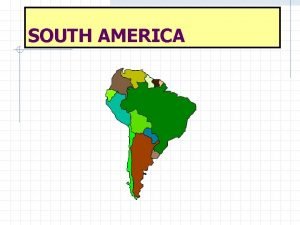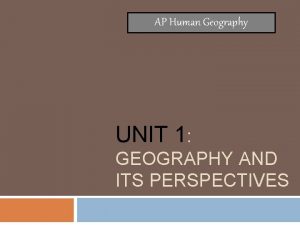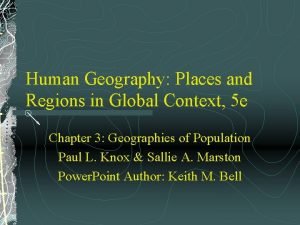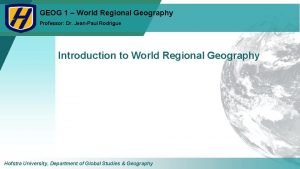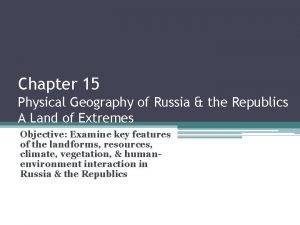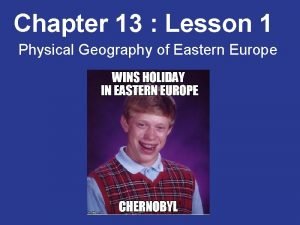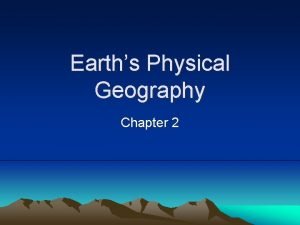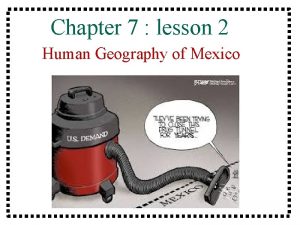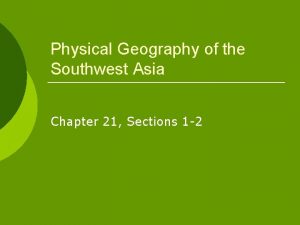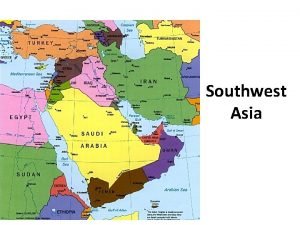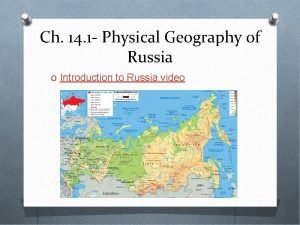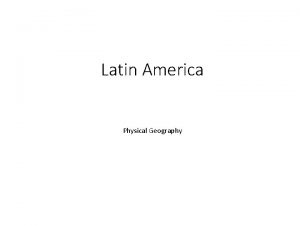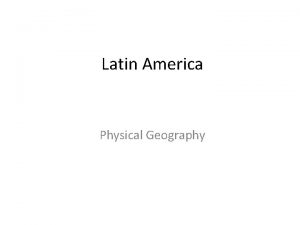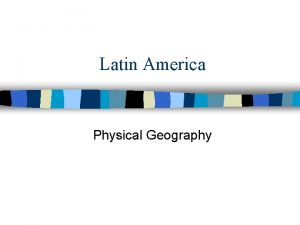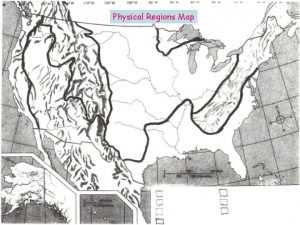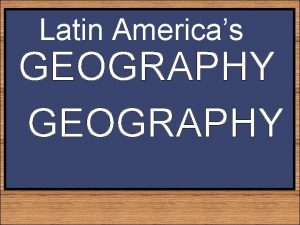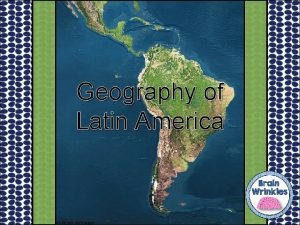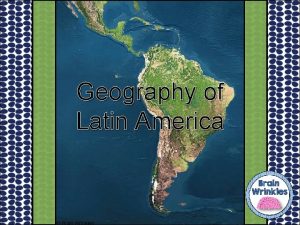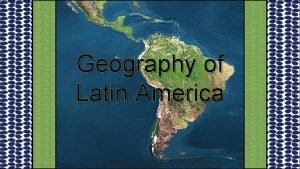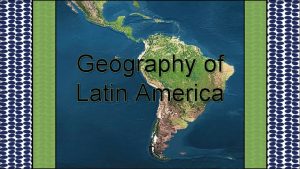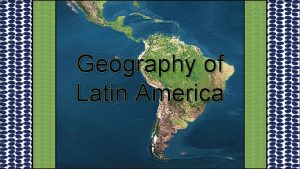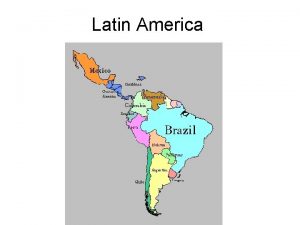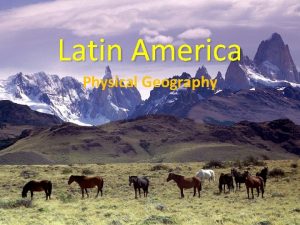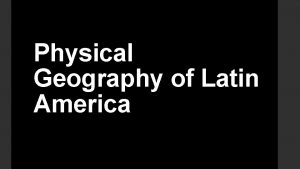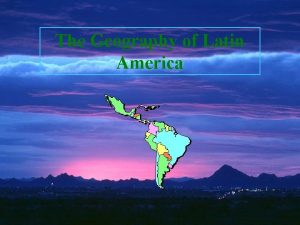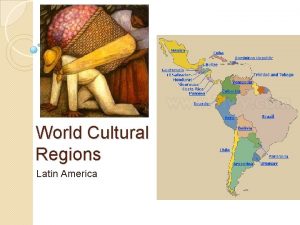Latin America Chapter 9 Physical Geography Regions of





































- Slides: 37

Latin America Chapter 9 Physical Geography

Regions of Latin America Mexico Central America Caribbean South America

Landforms • The Andes Mountains– part of the mountain range that runs through a portion of North, Central and South America. • United States- The Rocky Mountains • Central America- The Sierra Madres • South America- the Andes

Andes Mountains • Longest mountain range in the world • Stretches 4, 500 miles from north to south, along the west coast of South America • Highest peak, Aconcagua, rises 23, 000 feet Aconcagua

Landforms PLAINS • Llanos - vast tropical grassland plain situated at the east of the Andes in Colombia & Venezuela (cattle ranching) • Pampas - fertile plains in Argentina, Uruguay, & Brazil (grain, cattle, & sheep) • Cerrado – flat savannas found in the Amazon River Basin in Brazil PLATEAUS • Patagonia – cold, windswept plateau in Argentina & Chile • Altiplano – high plateau in Chile, Argentina, Bolivia & Peru

Amazon River • Longest River in the Western Hemisphere • Greatest total water flow of any river, carrying more than the Mississippi, Nile, and Yangtze rivers combined • Drainage area, called the Amazon Basin, is the largest of any river system

Amazon River

Amazon River

Amazon River

Paraná River • 2 nd longest river system in South America • Starts in Brazilian highlands • Paraguay & Uruguay river systems • Most important commercial highway Rio Parana from Encarnacion, Paraguay, looking to Posadas, Argentina

Orinoco River • Mainly in Venezuela • More than 1, 500 miles long into the Atlantic • Some of the areas drained by the Orinoco are home to the few remaining Native American peoples, such as the Yanomamo

Lake Titicaca • Highest commercially navigable lake in the world (12, 536 ft. above sea level) • South America’s largest freshwater lake • Located in the Altiplano high in the Andes on the border of Peru and Bolivia

Lake Nicaragua • Largest lake in Central America • Located in Nicaragua • Called “The Sweet Sea” • Has sizeable waves and archipelagos of islands • Lake Nicaragua has the only species of freshwater sharks in the whole world.

Angel Falls • World’s highest uninterrupted waterfall at 3, 230 feet • Located in Venezuela • The waterfall was not known to the world until its official discovery in 1933 by the American aviator, James Crawford Angel, on a flight while searching for gold. • 16 times the height of Niagara Falls

Islands of the Caribbean • Three Main Island Groups make up the West Indies: The Bahamas The Greater Antilles The Lesser Antilles

The Bahamas – Made up of hundreds of islands off of the southern tip of Florida.

Greater Antilles • Greater Antilles – Large islands in the Caribbean – Cuba, Jamaica, Hispaniola (Haiti & Dominican Republic), Puerto Rico

Lesser Antilles • Lesser Antilles – Smaller islands in the region SE of Puerto Rico – Divided into the Windward (winds that blow across them) and Leeward (sheltered) Islands

Mineral Resources • Bauxite (used to make aluminum) • Copper • Tin • Iron • Lead • Nickel • Silver • Gold Bauxite

Energy Resources • Oil – Venezuela & Mexico • Coal • Natural gas Trinidad • Uranium • Hydroelectric power - Brazil

Varied Climate & Vegetation • Varied climate and vegetation due to several factors: – Spans a great distance on each side of the equator – Big changes in elevation because of massive mountains – Warm currents of the Atlantic Ocean & the cold currents of the Pacific Ocean affect the climate

Tropical Climate Zones • Tropical Wet – Rain forests – Hot and rainy year round – Most of Brazil • Tropical Wet & Dry – Savannas – Hot climates with seasonal rains – Found of Brazil, Colombia, & Argentina

Amazon Rainforest South America • Covers 1. 2 billion acres • More than 1/5 of the rainforest has already been destroyed • One square kilometer of the Amazon rainforest can contain about 90, 000 tons of living plants.

Amazon Rainforest • The region is home to 2. 5 million insect species, tens of thousands of plants, and some 2, 000 birds and mammals. Tapir Orchid

Dry Climate Zones • Desert – Less than 10 inches of precipitation a year – Northern Mexico, coast of Peru, Atacama Desert in Chile, part of Patagonia • Semiarid – Generally dry, with some rain – Parts of Mexico, Brazil, Uruguay, & Argentina

Atacama Desert • Located in Chile and Peru • Driest desert on Earth • Rich deposits of copper and other minerals

Mid-Latitude Climate Zones • Humid Subtropical – Rainy winters and hot, humid summers – Varied vegetation – Parts of Paraguay, Uruguay, southern Brazil, southern Bolivia, and northern Argentina • Mediterranean – Hot, dry summers and cool, moist winters – Chapparal vegetation – Located in part of Chile • Marine West Coast – Cool, rainy winters and mild, rainy summers – Forests – Southern Chile & Argentina • Highlands – Moderate to cold, depending on elevation – Mountains of Mexico & South America

Human/Environment Interaction • • Slash-and-Burn farming Terraced farming Urbanization Tourism

Slash-and-Burn Farming - Used by native peoples to clear fields - Cut trees, brush, grasses and burned the debris to clear the field • Today, farmers practice this method to clear land for farming in the Amazon River basin • Sometimes use destructive farming practices • Soil is exhausted after a few years and all nutrients have been drained from the soil • Then they move on and clear another spot • This is one of the reasons for the shrinking of the rainforest

Before & After

The aftermath of slash and burn farming in the Amazon.

Terraced Farming • Ancient technique for growing crops on hillsides or mountain slopes • Cut step-like horizontal fields into hillsides and slopes • Allow steep land to be cultivated for crops • Reduces soil erosion

Urbanization • Push and Pull factors: People are moving from rural to urban areas in search of better opportunities.

Push Factors • Push factors: reasons people move away from rural areas • Ex: Poverty, poor medical care, poor educational opportunities, lowpaying jobs

Pull Factors • Pull factors: reasons people are drawn to the cities. • Ex: Possibilities for work, education, medical care.

Urban Sprawl • • Unemployment Crime Illegal Drug trafficking Slums Pollution Sanitation Shortages of clean drinking water and housing

Tourism • Advantages of Tourism – Create jobs – Reduction of the income gap between rich and poor • Disadvantages of Tourism – – Congestion Pollution gap between tourists and poor residents creates resentment Public debt due to borrowing money to build tourist facilities – Often, the owners of the hotels and airlines do not live in the country and the profits go elsewhere
 Chapter 8: the physical geography of latin america answers
Chapter 8: the physical geography of latin america answers Why called latin america
Why called latin america Physical features of south america
Physical features of south america South america highlands
South america highlands Unit 3 latin america
Unit 3 latin america Cultural geography of latin america
Cultural geography of latin america Much of latin america lies between
Much of latin america lies between Physiographic regions of north america
Physiographic regions of north america Voluntary trade comprehension check answers
Voluntary trade comprehension check answers Traje tipico de soloma
Traje tipico de soloma Web quest: geography of the spanish speaking world
Web quest: geography of the spanish speaking world Lesson 1 latin america africa and the middle east
Lesson 1 latin america africa and the middle east Physical features of latin america
Physical features of latin america Latin america physical features map
Latin america physical features map Where is latin
Where is latin Physical features of south america
Physical features of south america The reach of imperialism
The reach of imperialism Chapter 11 today's issues in latin america
Chapter 11 today's issues in latin america Chapter 25 the consolidation of latin america
Chapter 25 the consolidation of latin america World major industrial regions
World major industrial regions Eight regions of north america
Eight regions of north america South america map regions
South america map regions Thematic map ap human geography
Thematic map ap human geography Human geography places and regions in global context
Human geography places and regions in global context Geography: realms, regions, and concepts (doc or html) file
Geography: realms, regions, and concepts (doc or html) file China population density
China population density Russia and the eurasian republics physical map
Russia and the eurasian republics physical map Chapter 15 lesson 1 physical geography of north africa
Chapter 15 lesson 1 physical geography of north africa Lesson 1 physical geography of eastern europe
Lesson 1 physical geography of eastern europe Earth's physical geography chapter 2
Earth's physical geography chapter 2 Guided reading activity lesson 2 human geography of mexico
Guided reading activity lesson 2 human geography of mexico States west of the mississippi
States west of the mississippi Chapter 21 physical geography of southwest asia
Chapter 21 physical geography of southwest asia Peninsulas and waterways in southwest asia
Peninsulas and waterways in southwest asia Chapter 14 the physical geography of russia answers
Chapter 14 the physical geography of russia answers America america you mean the world to me
America america you mean the world to me America 2 europe
America 2 europe Repetition in let america be america again
Repetition in let america be america again


